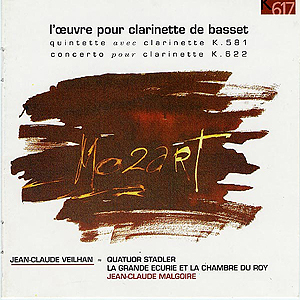|
The
basset-clarinet is not to be confused with the basset-horn,
though they are closely related. The latter is really a type of
alto clarinet, midway between the normal clarinet and the bass,
while the former is simply a clarinet with an extension downwards
of several semitones, for which Mozart is believed to have conceived
the two great masterpieces on this disc.
Specific
differences to the normally heard versions of the works are not
that noticeable, though they are in fact quite numerous; in the
first movement of the quintet, for example, there is the passage
of quaver figuration in the clarinet part that starts at 5:36, where
several of the lowest notes would be outside the range of the clarinet.
Similarly, in the concerto, there is the section at 2:58, where
once again, notes lower than the normal range are heard. There is
a pleasing logic in all of these adjustments, and they in no way
alter the familiar course of the music.
On the
other hand, the tone that Jean-Claude Veilhan produces may be less
acceptable to many ears. There is no doubting that he is an accomplished
and highly musical player, but his basset clarinet has a slightly
throaty quality, and doesn’t sing with the mellifluous ease that
modern ears are used to. Tone is not as even, either; one is occasionally
slightly uncomfortably aware of shifts in register. For me, this
was not a great problem, but others may find it so.
Certainly
the music is given performances of great character. Tempi in the
quintet are on the brisk side, though the larghetto retains
its tranquillity, and the menuetto has the benefit of an
urgent sense of forward movement. The concerto suffers from a rather
idiosyncratic recording. The acoustic is boxy, and the microphone(s)
is(are) very close, with practically no balance distinction between
soloist and orchestra. This takes a bit of getting used to, but
I found it grew on me, especially as the quality of playing in the
small accompanying ensemble is generally of high quality. More worrying
is the seeming clumsiness of the basset-clarinet as compared with
the clarinet. Many passages of intricate figuration sound distinctly
awkward in Veilhan’s hands, detracting from the elegance of the
work. I don’t believe that this is lack of sensitivity or technique
on his part, however, more in the nature of the longer, heavier
instrument.
But
these are performances worth hearing, if only for the unusual experience
of the instrument for which this music was originally intended.
Gwyn
Parry-Jones
|
CD Price: £ 11.50 Post-free Air Mail World-wide
- Download Price:
£ 7.11
Buy
CD:
Download all tracks:
FREE SOUND SAMPLES
(minimum 30 secs)
Click on the appropriate link. On the next page click on broadband
beneath the CD cover
Clarinet
quintet in A Major K.581 - Allegro
Clarinet
quintet in A Major K.581 - Larghetto
Clarinet
quintet in A Major K.581 - Menuetto
Clarinet
quintet in A Major K.581 - Andantino con Variazzioni
Clarinet
concerto in A Major K.622 - Allegro
Clarinet
concerto in A Major K.622 - Adagio
Clarinet
concerto in A Major K.622 - Rondo (Allegro)
You require QuickTime to listed to samples.
Get a free
QuickTime download here
|

